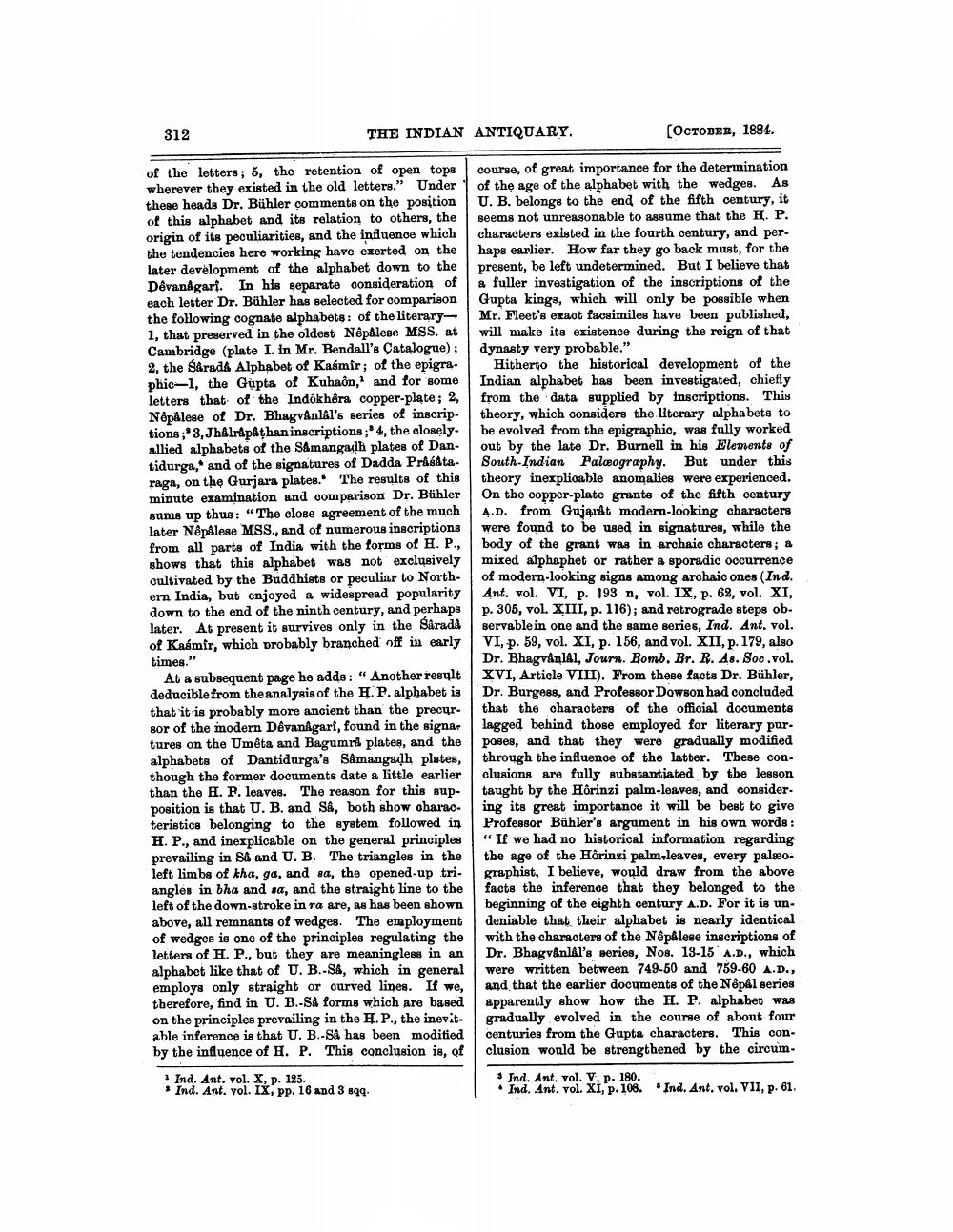________________
THE INDIAN ANTIQUARY.
312
of the letters; 5, the retention of open tops wherever they existed in the old letters." Under these heads Dr. Bühler comments on the position of this alphabet and its relation to others, the origin of its peculiarities, and the influence which the tendencies here working have exerted on the later development of the alphabet down to the Devanagari. In his separate consideration of each letter Dr. Bühler has selected for comparison the following cognate alphabets: of the literary1, that preserved in the oldest Népalese MSS. at Cambridge (plate I. in Mr. Bendall's Catalogue); 2, the Sarada Alphabet of Kasmir; of the epigra. phic-1, the Gupta of Kuhaôn, and for some letters that of the Indôkhêra copper-plate; 2, Nepalese of Dr. Bhagvanlal's series of inscriptions; 3, Jhalrapathan inscriptions; 4, the closelyallied alphabets of the S&mangadh plates of Dantidurga, and of the signatures of Dadda Prâsâtaraga, on the Gurjara plates. The results of this minute examination and comparison Dr. Bühler sums up thus: "The close agreement of the much later Nêpâlese MSS., and of numerous inscriptions from all parts of India with the forms of H. P., shows that this alphabet was not exclusively cultivated by the Buddhists or peculiar to Northern India, but enjoyed a widespread popularity down to the end of the ninth century, and perhaps later. At present it survives only in the Sarada of Kasmir, which probably branched off in early times."
At a subsequent page he adds: "Another result deducible from the analysis of the H. P. alphabet is that it is probably more ancient than the precursor of the modern Dêvanagari, found in the signa. tures on the Umêta and Bagumrå plates, and the alphabets of Dantidurga's Sâmangadh plates, though the former documents date a little earlier than the H. P. leaves. The reason for this supposition is that U. B. and Sâ, both show oharacteristics belonging to the system followed in H. P., and inexplicable on the general principles prevailing in Så and U. B. The triangles in the left limbs of kha, ga, and sa, the opened-up triangles in bha and sa, and the straight line to the left of the down-stroke in ra are, as has been shown above, all remnants of wedges. The employment of wedges is one of the principles regulating the letters of H. P., but they are meaningless in an alphabet like that of U. B.-S&, which in general employs only straight or curved lines. If we, therefore, find in U. B.-Så forms which are based on the principles prevailing in the H. P., the inevitable inference is that U. B.-SA has been modified by the influence of H. P. This conclusion is, of
[OCTOBER, 1884.
course, of great importance for the determination of the age of the alphabet with the wedges. As U. B. belongs to the end of the fifth century, it seems not unreasonable to assume that the H. P. characters existed in the fourth century, and perhaps earlier. How far they go back must, for the present, be left undetermined. But I believe that a fuller investigation of the inscriptions of the Gupta kings, which will only be possible when Mr. Fleet's exact facsimiles have been published, will make its existence during the reign of that dynasty very probable."
1 Ind. Ant. vol. X, p. 125.. Ind. Ant. vol. IX, pp. 16 and 3 sqq.
Hitherto the historical development of the Indian alphabet has been investigated, chiefly from the data supplied by inscriptions. This theory, which considers the literary alphabets to be evolved from the epigraphic, was fully worked out by the late Dr. Burnell in his Elements of South-Indian Palæography. But under this theory inexplicable anomalies were experienced. On the copper-plate grants of the fifth century A.D. from Gujarat modern-looking characters were found to be used in signatures, while the body of the grant was in archaic characters; a mixed alphaphet or rather a sporadic occurrence of modern-looking signs among archaic ones (Ind. Ant. vol. VI, p. 193 n, vol. IX, p. 62, vol. XI, p. 305, vol. XIII, p. 116); and retrograde steps ob. servable in one and the same series, Ind. Ant. vol. VI, p. 59, vol. XI, p. 156, and vol. XII, p. 179, also Dr. Bhagvanlal, Journ. Bomb. Br. R. As. Soc.vol. XVI, Article VIII). From these facts Dr. Bühler, Dr. Burgess, and Professor Dowson had concluded that the characters of the official documents lagged behind those employed for literary purposes, and that they were gradually modified through the influence of the latter. These conclusions are fully substantiated by the lesson taught by the Hôrinzi palm-leaves, and considering its great importance it will be best to give Professor Bühler's argument in his own words: "If we had no historical information regarding the age of the Hôrinzi palm-leaves, every paleographist, I believe, would draw from the above facts the inference that they belonged to the beginning of the eighth century A.D. For it is undeniable that their alphabet is nearly identical with the characters of the Nêpâlese inscriptions of Dr. Bhagvanlal's series, Nos. 13-15 A.D., which were written between 749-50 and 759-60 A.D., and that the earlier documents of the Nêpêl series apparently show how the H. P. alphabet was gradually evolved in the course of about four centuries from the Gupta characters. This conclusion would be strengthened by the circum
Ind. Ant. vol. V, p. 180.
Ind. Ant. vol. XI, p. 108. Ind. Ant. vol. VII, p. 61.




